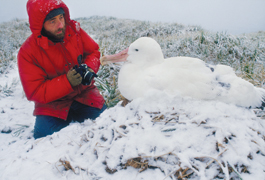home | metro santa cruz index | the arts | visual arts | review

Photograph by Frans Lanting
Ready for My Close-up: Photographer Frans Lanting regards a wandering albatross on South Georgia Island. The birds show little fear of humans.
In the Land of the Albatross
Wildlife photographer and Santa Cruz resident Frans Lanting trains his lens on the world's most remarkable birds.
By Traci Hukill
The journey across Campbell Island, halfway between New Zealand and Antarctica, was arduous. The video shows the hikers leaning into gale-force winds; off-camera, we learn, they were repeatedly tossed off their feet. Nine hours of struggle brought them to an astounding scene: a vast cliffside colony where thousands of black-browed albatrosses nest and tend their young in a cacophony of avian domesticity. There, famed wildlife photographer Frans Lanting captured one of his favorite shots of the entire two-year albatross project—an adult black-browed albatross nesting in the foreground, its mate soaring over the Pacific in the never-ending hunt for food. The image is similar to a dozen that graced the pages of National Geographic in December 2007. Santa Cruz audiences will get a larger-than-life view of these brilliant and vivid photographs this Saturday when Lanting makes a special presentation along with writer and videographer Chris Eckstrom and biologist Scott Shaffer. The afternoon and evening events, benefiting the Seymour Marine Discovery Center, continue a 20--year tradition of local Lanting shows that routinely sell out.
Speaking in his airy Westside studio, surrounded by his signature images of mountain lions, elephants and dolphins, Lanting says he was drawn to the albatrosses for their spectacular achievements. At the end of its 50-year life, a typical albatross will have flown 2 million to 4 million miles—without expending significant energy, thanks to unique design and a huge wingspan. The southern royal albatross, which also nests on Campbell Island, has, at 11 feet, the largest wingspan of any living bird. "Their natural history is full of superlatives," says Lanting.
Albatrosses may also be the hardest animals to resist anthropomorphizing. A video short produced by Eckstrom, who is married to Lanting, shows juvenile southern royal albatrosses gathering in groups called "gams" to practice courtship dance moves. Their squawking and awkward posturing brings to mind nothing so much as teenagers at the mall—and mastering the moves pays off in ways humans can identify with. All two dozen or so species of albatross mate for life, breeding only after several years of courtship and nest construction. Once a chick hatches, male and female take turns foraging; a bird might travel as much as 10,000 miles on a single trip before returning to the nest to regurgitate an oily, calorie-laden drink into the chick's greedy little maw.
But there was another reason Lanting wanted to do a project on albatrosses. As many as 200,000 a year are lured to the bait on longlines, then hooked and drowned when the lines sink. Lanting wanted to shed light on the problem, and on the solutions, which are easy and low-tech—even setting the bait to the side of the boat rather than behind it can cut down on albatross mortality. Sadly, the other man-made hazards threatening albatrosses are tougher to corral. When Lanting, Eckstrom, Shaffer and National Geographic writer Carl Safina visited the Midway Atoll halfway between the Hawaiian Islands and Japan to photograph, study and tag Laysan and black-footed albatrosses, chick corpses "littered" the beach, Safina writes. The body cavities of many contained cigarette lighters and other plastic that adult birds had unwittingly fed their chicks.
In yet another of Eckstrom's engaging video shorts (found at http://ngm.nationalgeographic.com, thousands of chicks, still coifed in down and feather, and learn to fly. The process is laborious, the going slow, but within a few weeks a chick that fell over the first time foam rushed up around its feet has mastered the running takeoff from the surface of the water. Soon it will be able to glide for days on end.
It's a sight we're privileged to see out on the Monterey Bay. Every summer, Shaffer says, black-footed albatrosses flock here by the thousands, drawn to the rich biological activity found at the brink of the bay's deep underwater canyon. It's just one of the reasons Lanting and Eckstrom—wildlife photography royalty—choose to make their home in Santa Cruz. "It's one of the most beautiful places on earth," says Lanting.
ALBATROSSES: BIRDS OF LEGEND IN A TIME OF TROUBLE is presented by Frans Lanting, Chris Eckstrom and Scott Shaffer on Saturday, Feb. 2, at 2 and 7pm at the Rio Theater, 1205 Soquel Ave., Santa Cruz. Tickets are $20 general/$15 Seymour Center Members, and may be purchased at the Seymour Center (831.459.3800), Bookshop Santa Cruz (831.423.0900) and the Frans Lanting Gallery (831.429.1331).
Send a letter to the editor about this story.
|
|
|
|
|
|